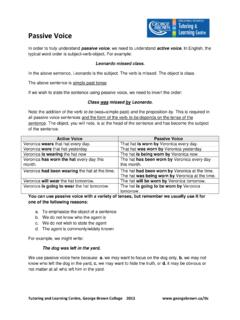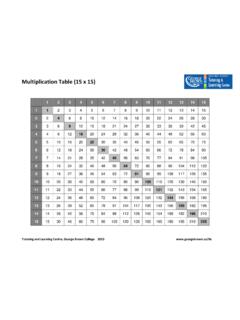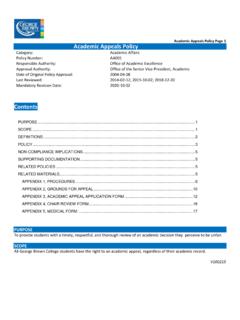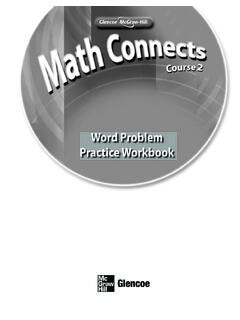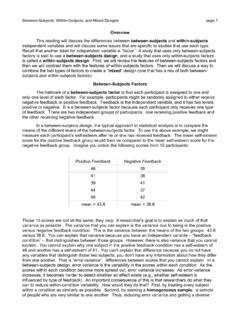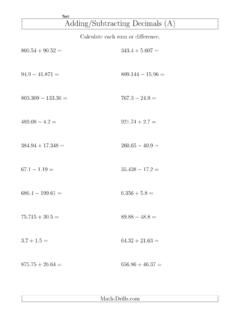Transcription of Adding and Subtracting Mixed Numbers and Improper …
1 Adding and Subtracting Mixed Numbers and Improper Fractions Tutoring and Learning Centre, George Brown College 2014 Just like our counting Numbers (1, 2, 3,..), fractions can also be added and subtracted. When counting Improper fractions and Mixed Numbers , we are counting the number wholes and parts. Note: The rules for Adding and Subtracting Improper fractions are the same as working with proper fractions. Case 1: Adding and Subtracting Improper Fractions with Common Denominators Step 1: Keep the denominator the same.
2 Step 2: Add or subtract the numerators. Step 3: If the answer is an Improper form, reduce the fraction into a Mixed number . Exercise 1: Add the fractions, + . Let s draw a picture to see what this looks like. The 4 in the denominator tells us that each whole is cut into 4 equal portions. By Adding the fractions we are grouping the total number of wholes and parts. How does the math work? Step 1: Since the two fractions have equal sized slices, keep the denominator the same, . Step 2: Add the numerators.
3 Step 3: Thus, we have wholes. We have 5 slices and each whole is made up of 4 slices, . We have 6 slices and each whole is made up of 4 slices, . Altogether, we have 2 wholes and 3 quarters, Adding and Subtracting Mixed Numbers and Improper Fractions Tutoring and Learning Centre, George Brown College 2014 Case 2: Adding and Subtracting Improper Fractions with Different Denominators Step 1: Find the Lowest Common Multiple (LCM) between the denominators.
4 Step 2: Multiply the numerator and denominator of each fraction by a number so that they have the LCM as their new denominator. Step 3: Add or subtract the numerators and keep the denominator the same. Step 4: If the answer is an Improper form, reduce the fraction into a Mixed number . Exercise 2: Subtract the fractions, . Step 1: List the multiples of 6 and 8. The Lowest Common Multiple between 6 and 8 is 24. Step 2: a) We need to find a number that when multiplied to the top and bottom of , we get the LCM (24) as the new denominator.
5 Since , we need to multiply the numerator and the denominator by 4. Thus, is equivalent to b) We need to find a number that when multiplied to the top and bottom of , we get the LCM (24) as the new denominator. Since , we need to multiply the numerator and the denominator by 3. Thus, is equivalent to Step 3: Since our fractions now have equal sized slices, we can subtract their numerators. Thus, we now have, of a whole.
6 Multiplies of 6: 6, 12, 18, 24, 30, 36, Multiplies of 8: 8, 16, 24, 32, 40, 48, Adding and Subtracting Mixed Numbers and Improper Fractions Tutoring and Learning Centre, George Brown College 2014 Case 3: Adding and Subtracting Mixed Numbers Method 1 Step 1: Convert all Mixed Numbers into Improper fractions. Step 2: Check! Do they have a common denominator? If not, find a common denominator. Step 3: When necessary, create equivalent fractions.
7 Step 4: Add or subtract the numerators and keep the denominator the same. Step 5: If the answer is an Improper form, reduce the fraction into a Mixed number . Exercise 3: Subtract the fractions, . Step1: Convert both Mixed Numbers into Improper fractions. Step 2: List the multiples of 4 and 7. The Lowest Common Multiple between 4 and 7 is 28. Step 3: a) We need to find a number that when multiplied to the top and bottom of , we get the LCM (28) as the new denominator. Since , we need to multiply the numerator and the denominator by 7.
8 Thus, is equivalent to b) We need to find a number that when multiplied to the top and bottom of , we get the LCM (28) as the new denominator. Multiplies of 4: 4, 8, 12, 16, 20, 24, Multiplies of 7: 7, 14, 21, 28, Adding and Subtracting Mixed Numbers and Improper Fractions Tutoring and Learning Centre, George Brown College 2014 Since , we need to multiply the numerator and the denominator by 4.
9 Thus, is equivalent to Step 4: Since our fractions now have equal sized slices, we can subtract their numerators. Subtracting their numerators we have, of a whole. Step 5: Thus, we have wholes. Case 4: Adding and Subtracting Mixed Numbers Method 2 In this second method, we will break the Mixed number into wholes and parts. Step 1: Add or subtract the whole number part. Step 2: Check! Does the fraction part share a common denominator? If not, find one.
10 Step 3: When necessary, create equivalent fractions. Step 4: Add or subtract the numerators of the fraction part and keep the denominator the same. Step 5: If the answer is an Improper form, reduce the fraction into a Mixed number . Exercise 4: Jessica is years old today. How old was she years ago? Since we are looking at the difference between her current and past ages, our equation will look like, . Step 1: Subtract the whole number part, Step 2: List the multiples of 2 and 4.
